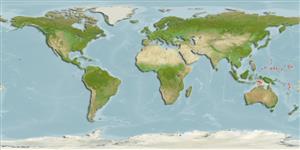Common names from other countries
>
Kurtiformes (Nurseryfishes, cardinalfishes.) >
Apogonidae (Cardinalfishes) > Apogoninae
Etymology: luteus: From the Latin for yellow in reference to its yellow coloration in life (Ref. 33415).
More on authors: Randall & Kulbicki.
Environment: milieu / climate zone / depth range / distribution range
Ecología
marino asociado a arrecife; rango de profundidad 1 - 49 m (Ref. 37816). Tropical
Distribución
Países | Áreas FAO | Ecosistemas | Ocurrencias, apariciones | Point map | Introducciones | Faunafri
Western Central Pacific: Philippines to the Marshall Islands.
Tamaño / Peso / Age
Maturity: Lm ? range ? - ? cm
Max length : 4.4 cm SL macho / no sexado; (Ref. 33415)
Short description
Claves de identificación | Morfología | Morfometría
Espinas dorsales (total) : 8; Radios blandos dorsales (total) : 9; Espinas anales: 2; Radios blandos anales: 8; Vértebra: 24. Predorsal scales 4; preopercular edge serrate; preopercular ridge smooth to slightly crenulate; body depth 2.9-3.3 in SL; yellow with six narrow blue stripes on head, the two upper stripes usually continue faintly as broader purplish stripes on body; a blue-edged yellow stripe basally in second dorsal and anal fins; dorsal profile of head slightly convex (Ref. 33415).
Inhabits sheltered clearwater areas of lagoon and seaward reefs. Aggregates under ledges, in holes, or even among spines of sea urchins. Feeds on planktonic crustaceans and small invertebrates by day and night (Ref. 37816).
Life cycle and mating behavior
Maturities | Reproducción | Spawnings | Egg(s) | Fecundities | Larva
A mouth-brooder. Distinct pairing during courtship and spawning (Ref. 205).
Myers, R.F., 1999. Micronesian reef fishes: a comprehensive guide to the coral reef fishes of Micronesia, 3rd revised and expanded edition. Coral Graphics, Barrigada, Guam. 330 p. (Ref. 37816)
IUCN Red List Status (Ref. 130435)
CITES (Ref. 128078)
Not Evaluated
Threat to humans
Harmless
Human uses
Herramientas
Special reports
Download XML
Fuentes de Internet
Estimates based on models
Preferred temperature (Ref.
115969): 28.1 - 29.1, mean 28.5 (based on 20 cells).
Phylogenetic diversity index (Ref.
82804): PD
50 = 0.5000 [Uniqueness, from 0.5 = low to 2.0 = high].
Bayesian length-weight: a=0.01122 (0.00528 - 0.02384), b=3.10 (2.92 - 3.28), in cm Total Length, based on LWR estimates for this (Sub)family-body shape (Ref.
93245).
Nivel trófico (Ref.
69278): 3.5 ±0.49 se; based on food items.
Resiliencia (Ref.
120179): Alto, población duplicada en un tiempo mínimo inferior a 15 meses (Preliminary K or Fecundity.).
Fishing Vulnerability (Ref.
59153): Low vulnerability (10 of 100).
